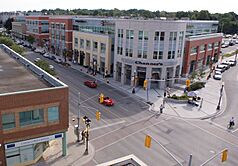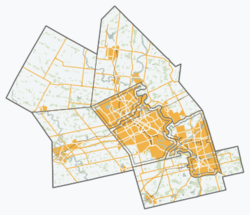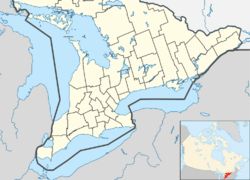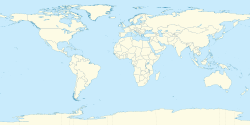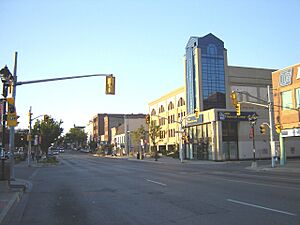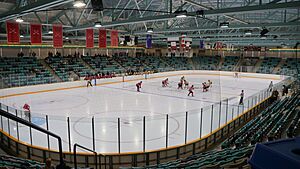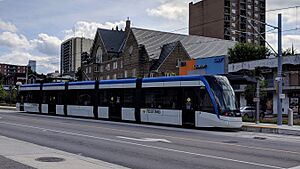Waterloo, Ontario facts for kids
Waterloo is a city in Ontario, Canada. It's one of three main cities in the Regional Municipality of Waterloo. Waterloo is about 94 kilometers (58 miles) west-southwest of Toronto. Because it's so close to the city of Kitchener, people often call them "Kitchener–Waterloo" or "K-W," also known as "The Twin Cities."
Even though there have been tries to combine Kitchener and Waterloo, they remain separate cities. In 2021, Waterloo had a population of 121,436 people.
Quick facts for kids
Waterloo
|
|||
|---|---|---|---|
| City of Waterloo | |||
|
Uptown Waterloo
Waterloo City Hall
Ion rapid transit
The Huether Hotel
Perimeter Institute
Davis Center (UW)
Seagram Lofts
|
|||
|
|||
| Motto(s):
Stability
|
|||
| Country | Canada | ||
| Province | Ontario | ||
| Region | Waterloo | ||
| Incorporated | May 27, 1857 | ||
| Area | |||
| • Land | 64.06 km2 (24.73 sq mi) | ||
| Elevation | 329 m (1,079 ft) | ||
| Population
(2021)
|
|||
| • City (lower-tier) | 121,436 (47th) | ||
| • Density | 1,895.8/km2 (4,910/sq mi) | ||
| • Metro | 575,847 (10th) | ||
| • Metro density | 527.2/km2 (1,365/sq mi) | ||
| Demonym(s) | Waterluvian | ||
| Time zone | UTC−5 | ||
| • Summer (DST) | UTC−4 | ||
| Forward sortation area |
N2J to N2L, N2T to N2V
|
||
| Area codes | 519, 226, and 548 | ||
| Website | www.waterloo.ca | ||
Contents
History of Waterloo
Early Peoples and First Settlers
Long ago, Indigenous groups like the Iroquois, Anishinaabe, and Chonnonton lived in the area.
After the American Revolution, a Mohawk leader named Joseph Brant asked for land around the Grand River. This land was given to the Mohawk and Six Nations people.
Later, a man named Richard Beasley bought a large piece of this land. To pay for it, he sold parts of it to new settlers.
Mennonite Settlers Arrive
The first big group of immigrants to the area were Mennonites from Pennsylvania, USA. In 1800, Beasley sold over 14,000 acres to them. A group of 26 Mennonites bought all the remaining land from Beasley in 1803.
Many pioneers from Pennsylvania bought land from this group. Their farms were often very large, sometimes 400 acres or more.
Waterloo's Growth in the 1800s
Abraham Erb is often called the founder of Waterloo. He came from Pennsylvania in 1806. He bought 4,000 acres and built a sawmill in 1808 and a grist mill in 1816. These mills helped the area grow.
The first school in Waterloo was a log building built in 1820 on land donated by Erb. This building still stands today in Waterloo Park.
In 1816, the new Waterloo Township was named after Waterloo, Belgium. This was where the Battle of Waterloo happened, ending the Napoleonic Wars. After this war, many German immigrants came to the area. By the 1840s, Germans were the largest group of people.
In 1857, Waterloo became a village. By 1876, it was a town. In 1911, most Waterloo residents (76%) had German family backgrounds.
Waterloo in the 1900s and 2000s
Waterloo became a city in 1948. The city grew a lot because of the University of Waterloo. This university attracted many technology companies to Waterloo.
For example, Research in Motion (now BlackBerry Limited), which made the BlackBerry phone, started here in 1984. The growth of the universities and tech companies created many jobs.
In the 1980s, Waterloo became known as a "post-industrial city." This means it changed from making things in factories to focusing on technology and services.
In 2011, the city council approved the Ion, a light rail train system. Construction started in 2014, and the Ion began service in 2019. It connects Waterloo and Kitchener.
Waterloo's Geography
Waterloo's city center is near the intersection of King and Erb streets. In the past, the city center was a bit different, but many old buildings were taken down between 1965 and 1969.
Waterways and Land
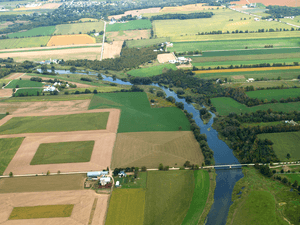
The Grand River flows along the east side of Waterloo. A smaller stream called Laurel Creek flows through the city, including the University of Waterloo and Waterloo Park.
In the west part of the city, the Waterloo Moraine is a special area that provides drinking water for over 300,000 people. This area has gentle hills.
Waterloo's Climate
Waterloo has a climate with warm, humid summers and cold winters. Compared to other parts of Canada, the weather here is quite moderate. Summer temperatures usually happen from mid-May to late September. It's common for temperatures to go above 30°C (86°F) several times each summer.
Waterloo's People
Population Growth
Waterloo has grown a lot over the years. In 1841, only about 200 people lived here. By 2021, the population was 121,436. The city's population density is about 1,895 people per square kilometer.
Ethnic Backgrounds
In 2021, many people in Waterloo reported their family backgrounds. The most common were German (17.9%), English (17.0%), Scottish (14.6%), and Irish (14.3%). Other backgrounds include Chinese, Indian, and French. About 1.3% of the population are Indigenous people.
Religions and Languages
In 2021, almost half of the people (45.8%) in Waterloo identified as Christian. Many people (37.7%) said they had no religious affiliation. Other religions like Muslim, Hindu, and Sikh are also present.
English is the main language spoken, with 64.6% of the population reporting it as their first language in 2021. Other languages spoken include Mandarin, Arabic, and German.
Waterloo's Economy
Waterloo has a strong economy based on knowledge and services. It's known for its insurance and high-tech industries, thanks to its two universities.
The biggest employers in the city include Sun Life Financial, the University of Waterloo, Manulife Financial, BlackBerry, Sandvine, and Wilfrid Laurier University.
Waterloo is also home to important research centers, like the Perimeter Institute for Theoretical Physics (for science) and the Institute for Quantum Computing (for computer and engineering research).
The city is part of "Canada's Technology Triangle" (CTT), which works to promote the region for business around the world.
Technology Companies
Waterloo has many high-tech companies. The most famous is BlackBerry, which has its main office here. Other notable tech companies include Aeryon Labs, Dalsa, Descartes Systems Group, Maplesoft, MKS Inc., ON Semiconductor, OpenText Corporation, Sandvine, and Vidyard.
Many large international tech companies like Google, SAP, Oracle, and Intel also have offices in Waterloo.
Insurance and Other Industries
Before it was known for tech, Waterloo was sometimes called "the Hartford of Canada" because of its many insurance companies. Companies like Waterloo Mutual Insurance and Mutual Life Assurance started here. Today, Manulife and Sun Life have their Canadian headquarters in Waterloo.
In the past, breweries and distilleries were also important. The distiller Seagram was originally from Waterloo, but its plant closed in 1992.
Arts and Culture in Waterloo
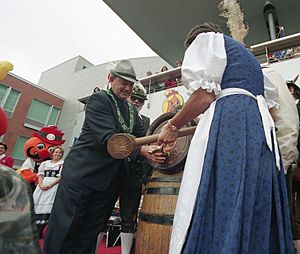
Kitchener–Waterloo Oktoberfest is a big nine-day festival held in both Kitchener and Waterloo. It's the second-largest Oktoberfest celebration in the world, after the one in Germany! It attracts over 700,000 visitors each year.
Tri-Pride is an annual LGBT pride festival held in Cambridge, Kitchener, and Waterloo during Pride Month.
The Kitchener–Waterloo Symphony performs many concerts each year. The Waterloo Busker Carnival is a fun festival in August where street performers entertain crowds for free.
Popular Attractions
Some popular places to visit in Waterloo include:
- The Canadian Clay and Glass Gallery
- The Waterloo Central Railway
- The City of Waterloo Museum
- The Perimeter Institute for Theoretical Physics
- The St. Jacobs Farmers' Market (just outside the city)
- The University of Waterloo's Earth Sciences Museum
- Conestoga Mall
Recreation and Parks
Waterloo has many parks and places for fun activities. These include Waterloo Park, Bechtel Park, Laurel Creek Conservation Area, the Waterloo Memorial Recreation Complex, and RIM Park. The city also has over 150 kilometers (93 miles) of trails for walking and biking.
City Parks
Waterloo Park was created in 1890. This 45-hectare (111-acre) park in Uptown Waterloo has an animal farm, sports fields, and a splash pad. It's the oldest park in the city.
Bechtel Park is 44 hectares (109 acres) and has a dog park and soccer fields. Laurel Creek Conservation Area offers camping, trails, and water activities like canoeing and swimming.
The Waterloo Memorial Recreation Complex opened in 1993. It has an arena, swimming pools, and an indoor track. RIM Park opened in 2001 and features outdoor soccer fields, ice rinks, and baseball diamonds.
Trails for Exploring

Waterloo has a great network of trails for walking, hiking, and biking. By 2007, the city had 150 kilometers (93 miles) of trails, a big increase from 10 kilometers (6 miles) in 1987.
The 5-kilometer (3-mile) Iron Horse Trail connects Waterloo and Kitchener. The 76-kilometer (47-mile) Walter Bean Grand River Trail runs along the Grand River.
Sports in Waterloo
Waterloo has several sports teams. These include the Waterloo Wildfire (ringette), Waterloo Siskins (hockey), and Waterloo United (soccer). The universities also have their own sports teams: the Wilfrid Laurier Golden Hawks and the Waterloo Warriors.
Transportation in Waterloo
Roads and Highways
The main highway in Waterloo is Highway 85, which is part of the larger Conestoga Parkway. This highway connects Waterloo to other cities like St. Jacobs and Elmira to the north, and Kitchener and Cambridge to the south.
Public Transportation
Public transportation in the Waterloo Region is run by Grand River Transit (GRT). GRT operates many bus routes and the Ion rapid transit light rail line. The Ion line has 19 stations and connects shopping malls in north Waterloo and south Kitchener.
Waterloo also has GO buses that stop at the universities, connecting students and residents to places like Toronto and Milton.
Train Travel
Waterloo does not have regular passenger train service directly. However, the nearby Kitchener station can be reached by bus or the Ion train. From Kitchener station, you can take GO Transit trains to Toronto or Via Rail trains to other cities.
The Waterloo Central Railway is a fun tourist train that departs from the St. Jacobs Farmers' Market and offers scenic rides.
Air Travel
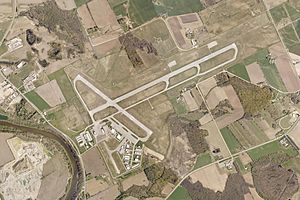
The Region of Waterloo International Airport is in nearby Breslau. It offers flights to several Canadian cities like Calgary, Halifax, and Vancouver, and some seasonal flights. For more international travel, most people use Toronto Pearson International Airport or John C. Munro Hamilton International Airport.
Services in Waterloo
Libraries for Learning
The Waterloo Public Library started in 1888. As of 2022, it has four branches: the Main Branch, Albert McCormick Branch, John M. Harper Branch, and the newest, Eastside Branch, which opened in 2022.
Fire and Police Services
Waterloo Fire Rescue provides fire protection and rescue services. They respond to fires, medical emergencies, and other incidents.
The Waterloo Regional Police Service handles general policing for Waterloo and nearby cities and townships. The universities in Waterloo also have their own Special Constables who help keep their campuses safe.
Education in Waterloo
Waterloo has many schools for students of all ages.
Elementary and High Schools
The Waterloo Region District School Board runs 21 elementary schools and three high schools in Waterloo: Bluevale Collegiate Institute, Laurel Heights Secondary School, and Waterloo Collegiate Institute.
The Waterloo Catholic District School Board runs 8 elementary schools and one high school, St. David Catholic Secondary School.
Universities and Colleges
Waterloo is home to two major universities:
- The University of Waterloo is a large public research university. In 2022, it had over 37,000 students. It's famous for having the largest co-op (work experience) program for students in the world.
- Wilfrid Laurier University had about 20,000 students in 2022 across its campuses.
Other colleges and university colleges in Waterloo include St. Jerome's University, St. Paul's University College, Conrad Grebel University College, Renison University College, and a campus of Conestoga College.
Media in Waterloo
The Waterloo Region Record is a daily newspaper that covers the whole region. The Waterloo Chronicle focuses on news just for the city of Waterloo.
For radio, CKMS-FM broadcasts from Waterloo. CKGL (570 News) is an AM radio station for the region. CKCO-DT (CTV Kitchener) is the only TV station broadcasting from the region.
Notable People from Waterloo
- Walter Bowman (born 1870), the first non-British player in the English Football League.
- Lorna Geddes (born 1943), a ballerina with the National Ballet of Canada.
- Nate Haller, a country musician and singer.
- Julie Karn (born 1996), a soccer player.
Images for kids
-
The Grand River, seen north-east of Waterloo
-
The Walter Bean Grand River Trail, with the Grand River in the background
-
Aerial photograph of the Region of Waterloo International Airport
See also
 In Spanish: Waterloo (Ontario) para niños
In Spanish: Waterloo (Ontario) para niños


